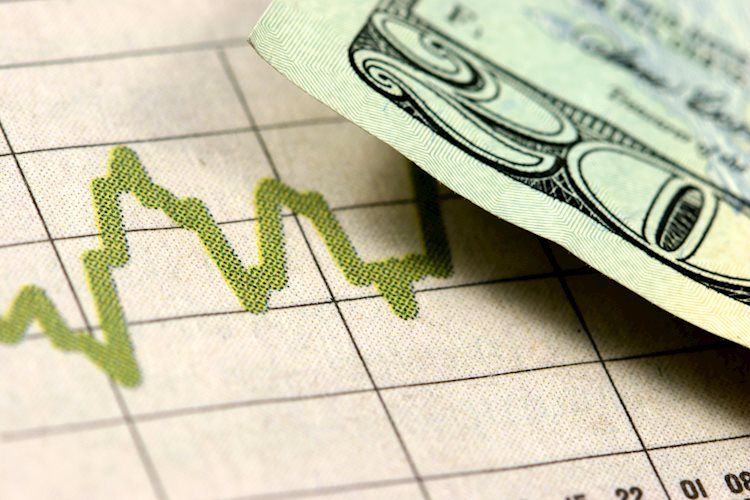- The DXY stands at 104.10 on Monday with mild gains.
- Fed’s dovish stance remains in place despite minimal chance of a March rate cut.
- January’s CPI figures on Tuesday are set to determine the timing of Fed cuts and USD dynamics.
The US Dollar (USD) remains firmly positioned at 104.10, demonstrating stability ahead of key US data releases expected this week. Financial markets keenly await economic reports on the Consumer Price Index (CPI), Producer Price Index (PPI), and Retail Sales data from January, which could potentially bolster the Dollar’s position further. Simultaneously, anticipation builds around upcoming inflation reports, expected to shed light on the economy’s performance and the Federal Reserve’s (Fed) future stance
In early February, the US Dollar saw notable gains following comments from Jerome Powell, the Federal Reserve Chair, indicating that a March cut in interest rates was unlikely. He stressed the need for more evidence of falling inflation before the Fed could consider reducing rates, making upcoming data crucial. Tuesday’s release of the US Consumer Price Index (CPI) for January is expected to significantly influence the short-term direction of the US Dollar.
Daily digest market movers: US Dollar holds steady as markets await key economic data, yields hold steady
- The Core CPI in January is expected to have risen by 3.7% YoY, while the headline measure is seen decelerating to 2.9% YoY.
- US Treasury yields are mildly down. The 2-year yield stands at 4.47%, the 5-year yield at 4.12%, and the 10-year yield at 4.17%.
- CME’s FedWatch Tool indicates a 20% possibility of a rate cut for the March meeting but may see some changes in case the US CPI from January comes in lower than expected. Those odds stand at around 50% for May.
Technical analysis: DXY bulls hold their ground, unable to conquer the 100-day SMA
The Relative Strength Index (RSI) remains stable within positive territory, indicating that upward force retains some punch in the dynamic of the index despite recent shifts. The Moving Average Convergence Divergence (MACD) also offers green flat bars, suggesting a positive trend in line with the bullish stance.
On the scope of the Simple Moving Averages (SMAs), the DXY appears to hover above the 20-day SMA and similarly above the 200-day SMA, indicating a strong bullish perspective in the longer horizon. However, it’s trading just beneath the 100-day SMA, suggesting some sell-off pressure in the near to intermediate term.
Given these indicators, it’s evident that buying momentum is more present than selling pressure. While the bearish movements have caused some disruption, the resilient undercurrent of bullish energy reflected in the RSI, MACD, and SMAs denotes an optimistic outlook in the overall trend.
US Dollar FAQs
The US Dollar (USD) is the official currency of the United States of America, and the ‘de facto’ currency of a significant number of other countries where it is found in circulation alongside local notes. It is the most heavily traded currency in the world, accounting for over 88% of all global foreign exchange turnover, or an average of $6.6 trillion in transactions per day, according to data from 2022.
Following the second world war, the USD took over from the British Pound as the world’s reserve currency. For most of its history, the US Dollar was backed by Gold, until the Bretton Woods Agreement in 1971 when the Gold Standard went away.
The most important single factor impacting on the value of the US Dollar is monetary policy, which is shaped by the Federal Reserve (Fed). The Fed has two mandates: to achieve price stability (control inflation) and foster full employment. Its primary tool to achieve these two goals is by adjusting interest rates.
When prices are rising too quickly and inflation is above the Fed’s 2% target, the Fed will raise rates, which helps the USD value. When inflation falls below 2% or the Unemployment Rate is too high, the Fed may lower interest rates, which weighs on the Greenback.
In extreme situations, the Federal Reserve can also print more Dollars and enact quantitative easing (QE). QE is the process by which the Fed substantially increases the flow of credit in a stuck financial system.
It is a non-standard policy measure used when credit has dried up because banks will not lend to each other (out of the fear of counterparty default). It is a last resort when simply lowering interest rates is unlikely to achieve the necessary result. It was the Fed’s weapon of choice to combat the credit crunch that occurred during the Great Financial Crisis in 2008. It involves the Fed printing more Dollars and using them to buy US government bonds predominantly from financial institutions. QE usually leads to a weaker US Dollar.
Quantitative tightening (QT) is the reverse process whereby the Federal Reserve stops buying bonds from financial institutions and does not reinvest the principal from the bonds it holds maturing in new purchases. It is usually positive for the US Dollar.
